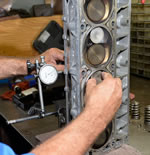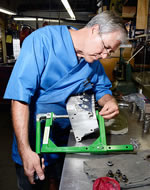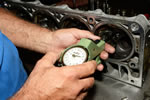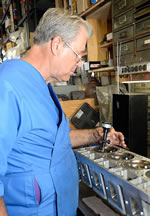Ruthless Pursuit of Power: The Mystique of the C6 Corvette LS7 Engine - Page 23 of 26
Ruthless Pursuit of Power: Lucky Seven Edition: The Mystique of the 7-Liter, 7000-RPM, LS7 - Page 23 of 26
 |
 |
by Hib Halverson
© May 2013— Updated: February 2016
No use without permission, All Rights Reserved
We sent an engine oil sample to Blackstone Laboratories for analysis. The results showed, of the so-called "wear metals," Blackstone found iron and copper to be above the "universal average". Blackstone spokesperson, Ryan Stark, told us that, while it was possible that high iron and copper numbers indicate the powdered metal valve guides and perhaps valve seats were wearing, since Blackstone had analyzed our engine's oil only once and did not have an adequate database of oil samplings from LS7s with mechanical problems, he could not conclusively state that wear was taking place. We, also, had Red Line Oil's now-retired Vice President and Chief Chemist, Roy Howell, look at Blackstone's results and he stated that, considering the mileage on the oil that the copper and iron numbers seemed nominal. He added that other wear metals along with "total base number" (TBN), viscosity and oxidation were all "Ok".
To get the bad valve guide news officially confirmed, we had our local dealer, Bunnin Chevrolet/Cadillac in Santa Barbara, California, remove the heads. Their technicians Wiggle Tested all the valves on the driver-side head–a much easier task when it's off the engine–and confirmed that it had intake guides which were worn beyond the service limit. Regardless of the number of out-of-spec guiides, measuring that much guide wear in an engine with a little over 16,000 miles on it had us concerned.
Uncomfortable with the inconsistency of wiggle testing results, with GM's agreement, we took the heads to Mark DeGroff's Cylinder Head Service and Machine Shop in Northridge, California. DeGroff, who's done all the author's cylinder head work for more than 20 years, first, Wiggle-Tested all the valves. This third wiggle test supported the results of the first two but resulted in measurements which were somewhat less then the first test we did.
Next, DeGroff disassembled the heads, measured all valve guides with a Sunnen Dial Bore Gauge (PN P310). DeGroff's direct measurements showed that the heads had intake guides worn beyond production tolerance, two just short of the service maximum and one worn beyond the service maximum.
Finally, using the Goodson Valve Seat Runout Gauge (PN VSG-375), Mark and I measured the concentricity of the seats and guides in the passenger side head and found three of the four intake seats had a lack of concentricity equal to or beyond .002-in., which, at the time, was the maximum allowable for warranty purposes. To read all the measuring data we accumulated, click here.
Eight months later, in March of 2015, General Motors revised the specifications for valve seat run out and .002-in became the "production maximum" and .003-in became the "service maximum". GM is now allowing 50% more nonconcentricity of valve guides and seats than before. While such a large increase in a wear specification which had remained the same for half-a-century raises questions about GM's reasoning behind the increase in allowable valve seat-to-guide nonconcentricity, additional research we undertook lends credibility to the .002-in production limit and it's safe to say that another .001-in of seat-and-guide-wear-driven runout would be acceptable in a used, but still-under-warranty, stock LS7 head.
We polled several cylinder head service sources about seat runout in modern OHV V8 heads and found that, while specifications varied somewhat, most were about the same as GM's production specification. One source told us that a good runout number for new, production cylinder heads is .001-in per inch of valve face diameter. Using that rule, GM should be holding at least 0022-in for runout. Another told us that runout of .002-in. or less is good for a new stock cylinder head. Two more told us the same thing: .002-in. for a stock head is ok.
That said, from a high-performance and racing perspective, by standards the performance aftermarket typically uses, .003-in is too much seat run-out and and many high-performance engine builders consider .002-in. unacceptable. The most common rmaximum run-out number we see from race engine builders or those who do racing head work is .001-in. and some who are really good with their Newen or Serdi valve-and-seat machines can hold max run-out to .0005-.0007-in. Obviously, from a seat run-out perspective, there is a significant advantage in having a service vendor such as Texas Speed and Performance, which uses Newen machines, doing the heads for your modified LS7 engine.
Making a Warranty Claim
DeGroff reassembled those heads. I returned them to Bunnin Chevrolet the next day and requested they be replaced under warranty on the basis of three wiggle tests demonstrating guide wear and seat run-out measurements demonstrating lack of concentricity. Eventually they found their way to GM Powertrain in Michigan for inspection.
Once it was begun, the administrative part of the warranty claim went quite smoothly. Generally, it followed General Motors' January 2013 Information Service Bulletin on LS7 Valve Guide Wear, except that we preempted a claim denial due to the engine not making unusual noise, not using too much oil and not turning on the MIL by paying Bunnin Chevy to wiggle test the engine. Once those heads proved to have worn guides, according to GM's wear specifications in force at the time, both GM and Bunnin moved quickly to replace the heads on the engine in our Z06, however, in another setback, the replacement parts were faulty.
 |
 |




